Acknowledgments
This photo book would not have been possible without the tireless work by many men and women who have made our company’s sports coverage the state’s best for decades.
The archival work of a few must be noted:
• The late Orville Henry, the longtime sports editor of the Arkansas Gazette whose attention to detail made many older photos readily accessible, and his longtime colleague Jim Bailey, who alongside Henry wrote the authoritative book on the Razorbacks’ history, a book leaned on many times for historical context to many of the older photos printed here.
• Charles Bickford, the late photographer for the Springdale Morning News whose personal archive was a treasure trove for photos during the tenures of Frank Broyles and Lou Holtz.
• Barry Arthur, Michelle Goad and Dede Green of the Arkansas Democrat-Gazette for their help obtaining and digitizing decades-old prints and negatives.
• The many great past and present photographers of the Arkansas Democrat-Gazette, Arkansas Democrat-Gazette, Arkansas Gazette, Arkansas Democrat, Hawgs Illustrated, Northwest Arkansas Times, Benton County Daily Record, Springdale Morning News, Rogers Morning News, Morning News of Northwest Arkansas and Sentinel Record whose photos are featured here.
Thank yous are also owed to the following people:
• Chuck Barrett
• Scottie Bordelon
• Charlie Fiss
• Ben Goff
• Clay Henry
• Bob Holt
• Harold Horton
• Ashley Jones
• Jack Jones
• Harry King
• Kyle Parkinson
• Pegeen Perry
• Brent Powers
• Chip Souza
• Spencer Tirey
• Rusty Turner
Finally, thank you to the fans of the Arkansas Razorbacks for your loyalty, passion and readership. Our coverage is made available for you and because of you.

Copyright © 2018 by Arkansas Democrat-Gazette
All Rights Reserved • ISBN: 978-1-59725-781-7
No part of this book may be reproduced, stored in a retrieval system or transmitted in any form or by any means, electronic, mechanical, photocopying, recording or otherwise, without prior written permission of the copyright owner or the publisher.
Published by Pediment Publishing, a division of The Pediment Group, Inc. www.pediment.com. Printed in Canada.
FOREWORD
THE RAZORBACKS ARE the tie that binds us all together. They’re part of our heritage, part of who we are as Arkansans.
We wrap our newborns in Razorback blankets. We wear our best Razorback shirt on school picture day. We call the Hogs at our wedding receptions. And I’ve been to more than one funeral where the departed’s devotion to the Razorbacks was duly noted.
The Razorbacks are how we mark time, and this collection is in many ways the story of our lives. I was in seventh grade on the Saturday that Teddy Barnes became “immortal.” I sat in the south end zone of War Memorial Stadium with my mom and sister.
As a matter of full disclosure, I skipped basketball practice to attend the game.
Just before halftime, Scott Bull lofted a deep pass into the back of the north end zone. From the opposite end of the stadium, no one knew until the officials’ hands were raised whether the
ball had been caught or not, much less whether Barnes’ feet stayed inbounds.
There was no in-stadium replay in 1975. It wasn’t until the next day, when we saw the picture in the newspaper, that we knew exactly what happened. That was 43 years ago, but I remember it like it was yesterday.
The fact is, we all have memories of attending, watching or even listening to Razorback games. Most all involve family members, some of whom aren’t here anymore. A grandparent perhaps, or a since departed friend; you’ll think about all of them when you see the pictures.
All the iconic moments are captured, and we will all be reminded again that even with all our technological advances, a picture is still worth a thousand words.
Go Hogs!
Chuck Barrett Voice of the Razorbacks


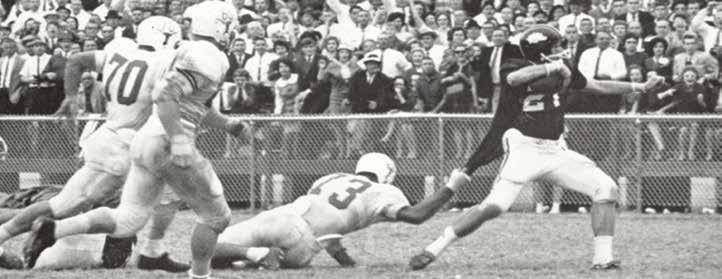

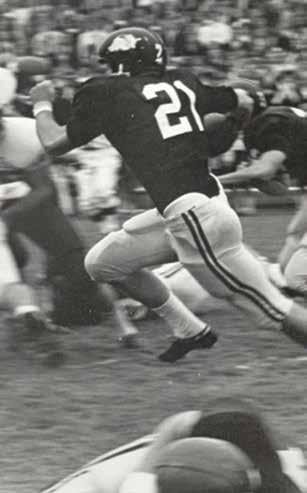


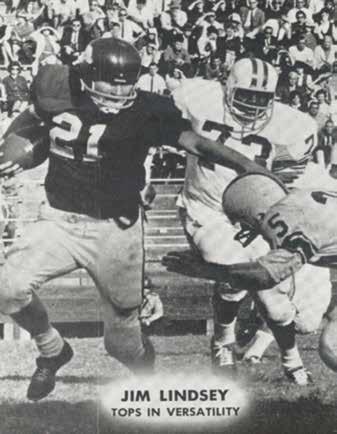

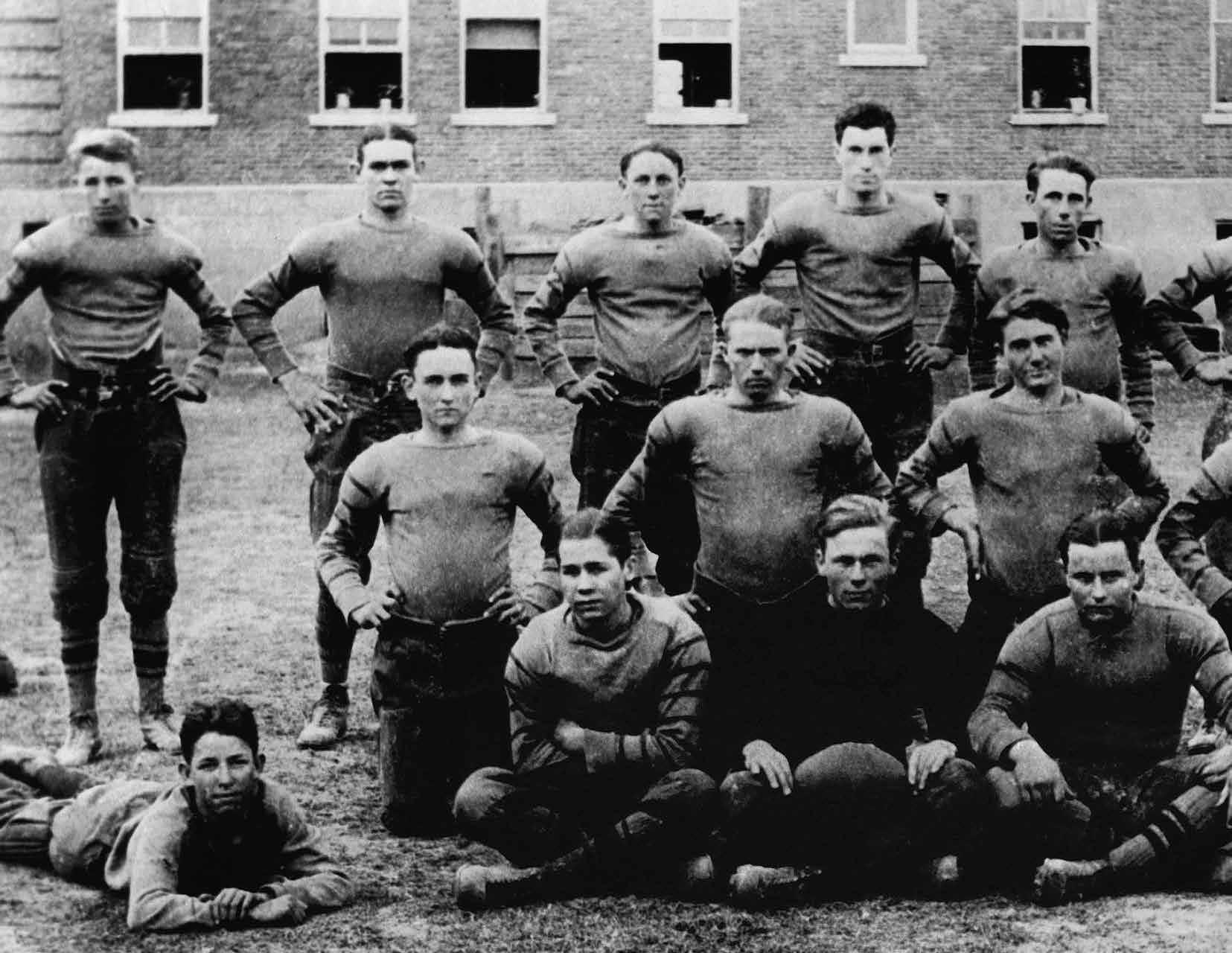

THE EARLY YEARS
AFTER A FEW YEARS of intramural games on campus, Arkansas fielded its first football team in 1894. The Razorbacks shut out a high school team from Fort Smith twice, but failed badly in its first game against a college opponent, losing 54-0 at Texas.
That season foretold much about Arkansas’ football program for the better part of its first half century. The Razorbacks were often good enough to win most of their games, but usually struggled against the best team they played each year.
The early record book, compiled through years of tedious research by longtime Arkansas publicist Bob Cheyne, details a number of losses to the likes of Texas, Oklahoma and LSU, oftentimes
by shutout or funny football scores ranging from 4-0 to 103-0.
Because most of Arkansas’ first half-century was played in relative obscurity or before the advent of modern action photography, we won’t attempt to recap many of the early games in a photo book. Instead, this chapter will largely highlight a number of the individuals who were prominent in Arkansas’ early years and who helped lay a foundation for the Razorbacks’ varying levels of success in the years following World War II. That’s when emerging media - such as our newspaper and a statewide radio network formed by Cheyne - helped bring football to the masses and make the sport a sensation in Arkansas.
ABOVE: The 1924 Razorbacks finished 7-2-1 with wins over Ole Miss and LSU. COURTESY ARKANSAS DEMOCRAT-GAZETTE

ABOVE: Members of Arkansas’ 1901 team pose for a photo. The Razorbacks were 3-5 that season with losses to two high school teams. COURTESY UNIVERSITY OF ARKANSAS
FAR RIGHT: John Shirley Wood was quarterback and team captain of Arkansas’ 1906 team that went 2-4-2. Wood later became a career military man and fought in both World Wars. Wood was an Army general in World War II and received the Distinguished Service Cross, the Distinguished Service Medal, the Silver Star, the Bronze Star and the Air Medal. COURTESY ARKANSAS DEMOCRAT-GAZETTE
RIGHT: Hugo Bezdek is credited with coining the Razorback nickname after Arkansas’ 16-0 win over LSU in Memphis by saying his team had played “like a wild band of razorback hogs.” Students voted to change the university mascot from the Cardinals to the Razorbacks the following year. Bezdek was 29-13-1 in five seasons as Arkansas’ coach and led the program to an undefeated record in 1909. He also coached at Oregon and Penn State, and in 1954 was inducted into the College Football Hall of Fame. COURTESY ARKANSAS DEMOCRAT-GAZETTE
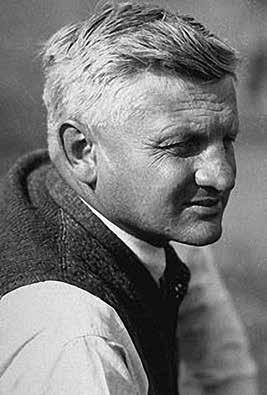
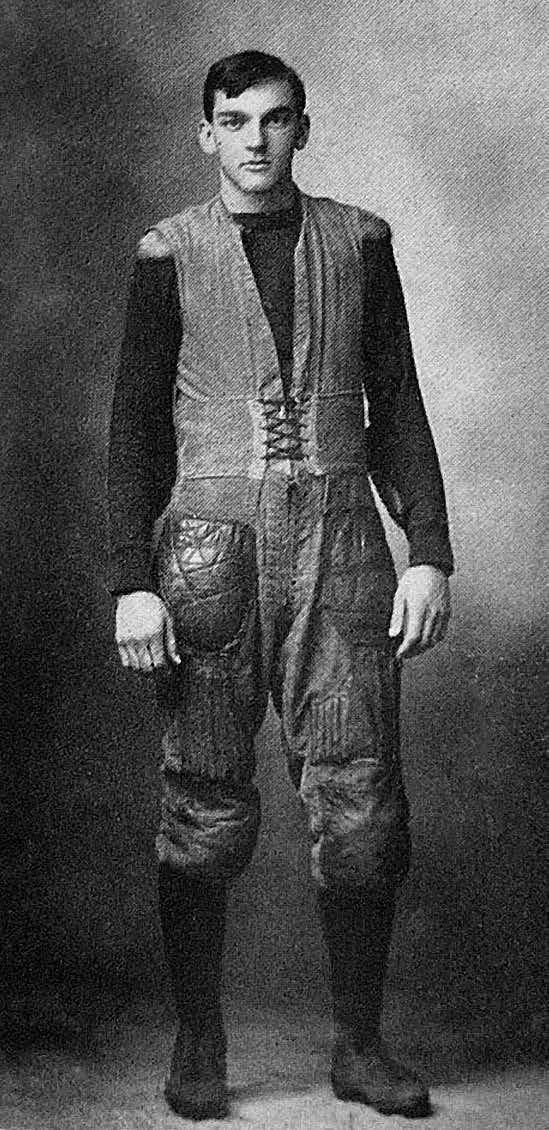
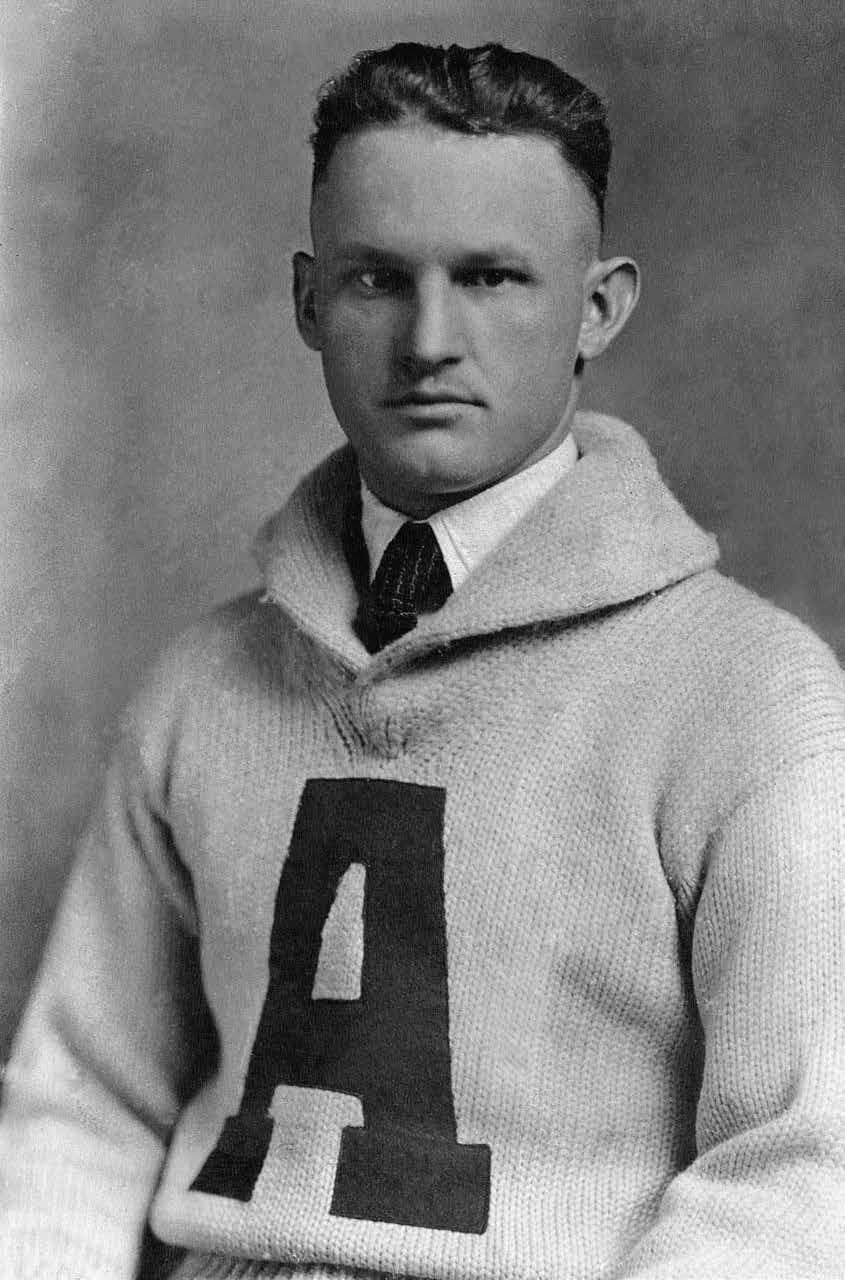

ABOVE: Tight end Wear Schoonover was Arkansas’ first All-American in 1929. During a game against Baylor that season, Schoonover set school records with 13 catches for 132 yards, and during a game against Centenary he intercepted five passes and returned one 92 yards for a touchdown. Schoonover also ran track and played basketball and baseball at Arkansas, and was a member of three SWC basketball championship teams. He was the first Arkansas player ever inducted into the College Football Hall of Fame. COURTESY ARKANSAS DEMOCRAT-GAZETTE
LEFT: Gene “Sodie” Davidson was an All-Southwest quarterback in 1916, 1917 and 1919. Although his stats were not recorded, his praises were sung in newspapers during his day. An Austin newspaper reporter once called him “a giant among pygmies,” a New Orleans reporter once wrote he was “the most finished player in the South,” and a Dallas reporter once wrote he single-handedly stopped multiple Texas touchdowns on defense, and on offense “attracted attention by his broken field running and passing.” COURTESY ARKANSAS DEMOCRAT-GAZETTE
For more than eight decades, First Security Bank has promised customers a better banking experience. At the heart of it all is that core commitment to hometown values and the delivery of personal service to the people of Arkansas.
It’s by being deeply invested “Only in Arkansas” that First Security has grown to become one of the state’s most trusted names in banking – with 77 locations, more than 1,000 employees, and backed by unparalleled financial strength.
The efforts of community bankers are deeply felt throughout our state. They are instrumental in building better communities, as they provide financial services to local residents, entrepreneurs and municipalities – all of which keep Arkansas’ rural, suburban and urban communities growing and thriving.
There’s a lot to be proud of in Arkansas, but few things compare to seeing the hard work and accomplishments of the people in our home state – including the Razorback athletes, coaches and staff. Thanks for giving us 125 years of reasons to cheer for the home team.


“Our vision is to be Arkansas’ premier financial services company providing the most responsive, innovative and secure financial solutions to our customers with exceptional personalized service.”


– Reynie Rutledge, chairman and CEO of First Security Bancorp




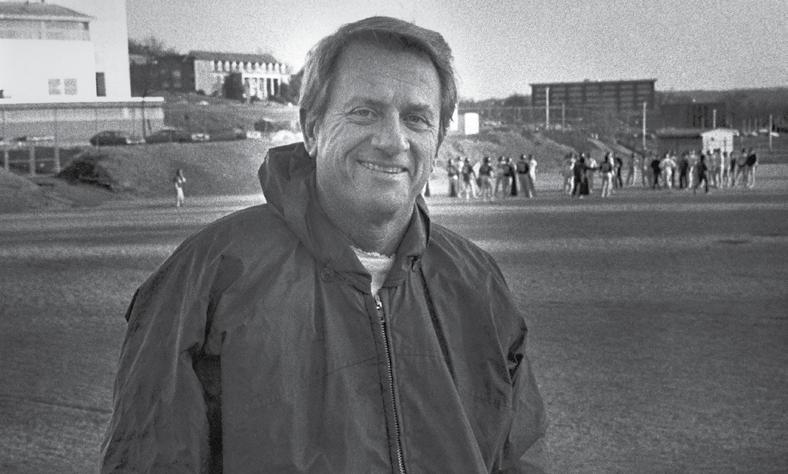
THE BROYLES YEARS
OF THE ARKANSANS who left their mark on the 20th Century, few were better known than Frank Broyles. If you loved college football, his was a household name.
Broyles devoted most of his adult life to the Razorbacks. After one season as head coach at Missouri, at 32 years old, he was hired by then-athletics director John Barnhill in December 1957 to lead Arkansas’ football team. He spent the next 57 years working for the Razorbacks in some capacity until his full-time retirement as a fundraiser in 2014.
Broyles was considered one of college football’s giants during an era that included Bear Bryant at Alabama, Darrell Royal at Texas and Ara Parseghian at Notre Dame. Broyles compiled a
record of 144-58-5 and led the Razorbacks to 10 bowl games in 19 seasons. In 1964, Broyles coached Arkansas to its only football national championship.
Many credit the success of his teams in changing the perception of Arkansas — both inside and outside the state — after the Little Rock Central High School desegregation crisis of 1957.
Broyles was inducted into numerous halls of fame, including the College Football Hall of Fame. In 1999, the Arkansas Democrat-Gazette named Broyles the state’s most influential sports figure of the century.
Dallas Cowboys owner Jerry Jones, who played for Broyles, called him the most important man to ever live in Arkansas.
Before becoming head coach at Missouri, Broyles
ABOVE: Frank Broyles, Dec. 2, 1967. COURTESY CHARLES BICKFORD
spent time as an assistant coach at Baylor, Florida and Georgia Tech. He often said it was during a trip to Fayetteville while an assistant coach at Baylor in the late ’40s that he became interested in the Razorbacks’ program because of the number of people in town who were headed to the football game. He called Arkansas his dream job.
Arkansas won the first of seven Southwest Conference championships in Broyles’ second season. The Razorbacks had nine finishes in the top 10.
Arkansas was named national champion by the Football Writers Association of America and Broyles the national coach of the year after an undefeated season in 1964, which ended with five consecutive regular-season shutouts before a 10-7 win over Nebraska in the Cotton Bowl.
Arkansas missed out on a potential second national championship when it was upset 14-7 by LSU in the Cotton Bowl the following year. The loss ended a 22-game winning streak.
Broyles had Arkansas on the cusp of another national championship in 1969 when the Razorbacks hosted Texas to end the regular season in what became known as The Big Shootout. President Richard Nixon attended the game, as did future president George H.W. Bush. Evangelist Billy Graham gave a pregame invocation.
Arkansas led 14-0 after three quarters, but the Longhorns scored on the first play of the fourth quarter and again with 3:58 remaining, two plays after one of the most famous plays of the decade, Right 53 veer pass — a 44-yard completion from Texas quarterback James Street to tight end Randy Pechel on fourth-and-3.
Nixon proclaimed Texas the national champion during a postgame presentation in the locker room. Broyles called it the most painful loss of his coaching career and rarely spoke about the game. He said he never watched the game film.
Broyles continued to coach the Razorbacks into the 1970s, winning his last conference championship in 1975. He added the title of athletics director in 1973, succeeding George Cole. Broyles hired Lou Holtz as his successor, beginning a long line of notable hires from his AD position. Among them were Ken Hatfield and Danny Ford to coach football; Eddie Sutton and Nolan Richardson to coach basketball; Dave Van Horn to coach baseball; and John McDonnell to coach track and field. Making notable hires began during Broyles’ time as head coach. He hired some of football’s most famous coaches as assistants, including Jimmy Johnson, Barry Switzer, Joe Gibbs, Johnny Majors and Hayden Fry, who combined to win six Super Bowls, as well as five national championships and 20 conference championships in college football.
Other notable assistants included Hatfield, Doug Dickey, Raymond Berry, Jackie Sherrill, Butch Davis, Fred Akers, Pat Jones, Harold Horton and Houston Nutt.
In 1996, the Broyles Award was established and is awarded each year to the most outstanding assistant coach in college football.
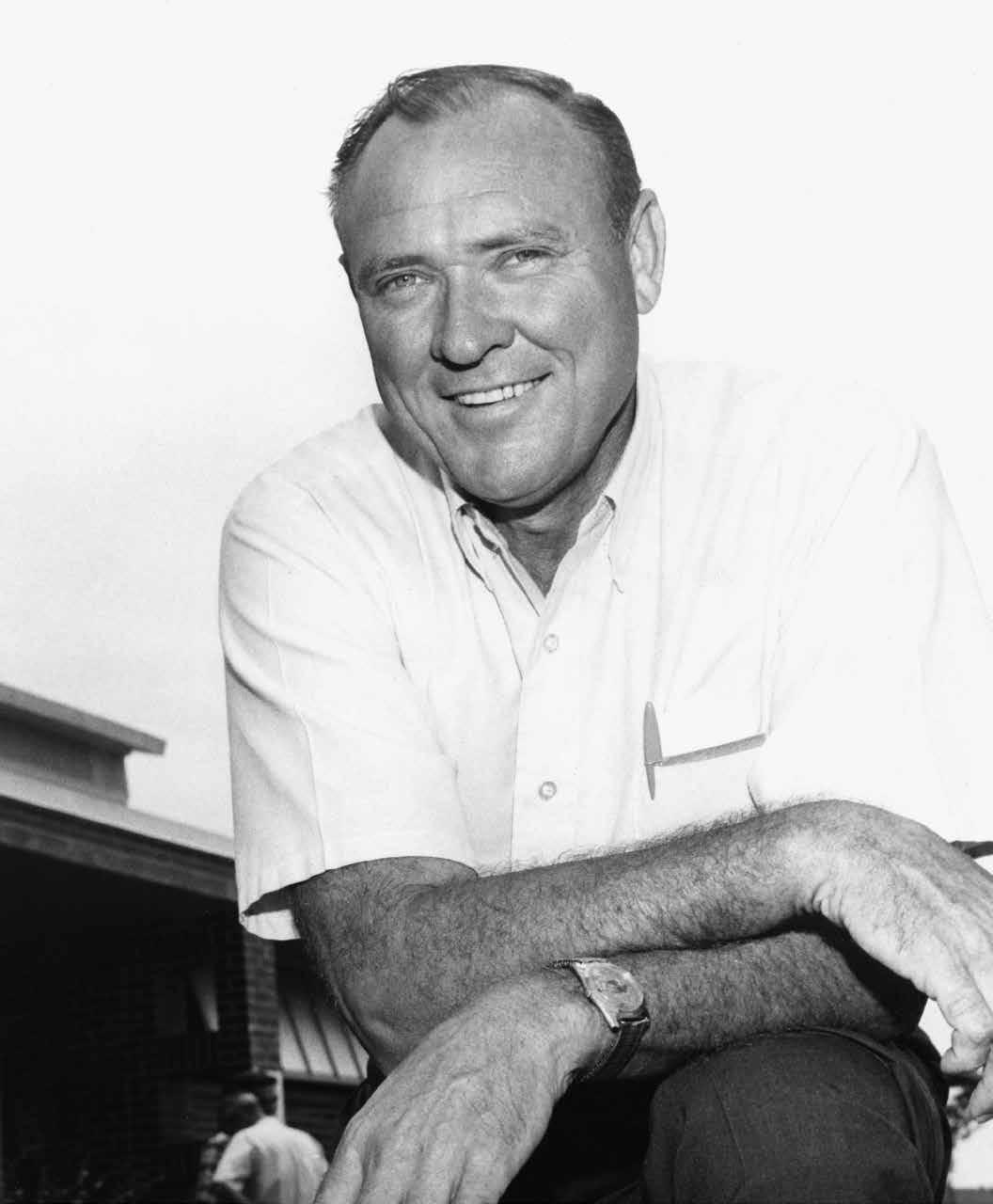

OPPOSITE: Wilson Matthews won 10 state championships in 11 seasons at Little Rock Central High School, then was hired to Frank Broyles’ first head coaching staff. Matthews was a close aide to Broyles, including as an assistant athletics director after their coaching tenures ended. Matthews is depicted in the Broyles Award trophy that is given annually to the most outstanding assistant coach in college football. COURTESY GENE PRESCOTT









Good coffee is always ethically sourced and carefully crafted. When you choose Westrock, you help shape a sustainable future for farmers and their families.



THE PETRINO YEARS
LATE ON A FOGGY NIGHT in December 2007, Bobby Petrino was introduced as Arkansas’ head coach to the delight of Razorback fans and to the scorn of national media.
Petrino had resigned his job with the NFL’s Atlanta Falcons earlier that day, informing his team he was leaving three weeks before the season ended via a photocopied letter in their lockers.
But to Arkansas fans, Petrino’s baggage didn’t matter. They longed for a coach that could compete for conference championships and produce high-scoring
offenses, and that is just what Petrino promised.
His hire was considered a home run during a search process that nearly saw Arkansas hire Tommy Bowden and Jim Grobe instead.
The Razorbacks improved each year under Petrino, from five wins his first season to a school-record tying 11 wins in his last. Along the way, Petrino’s teams beat the likes of LSU, Auburn and Georgia, and rewrote just about every offensive record. Arkansas reached No. 3 in the national rankings in 2011, but lost games to the eventual national
champion and eventual national runner-up, Alabama and LSU, by 24 points apiece. The Razorbacks’ consolation was a win over Kansas State in the Cotton Bowl, which gave them a top five national ranking for the first time in 34 years, and a 21-5 two-year record.
That was the final game Petrino would coach at Arkansas, however. A motorcycle accident less than four months later wrecked all he had built in Fayetteville, and set the Razorbacks’ program back for many years to come.
ABOVE: Bobby Petrino puts on an Arkansas hat after he was introduced as the Razorbacks’ head coach on Dec. 11, 2007. Jeff Long, left, led the coaching search despite not moving into the full-time role as athletics director until the following month. COURTESY JASON IVESTER

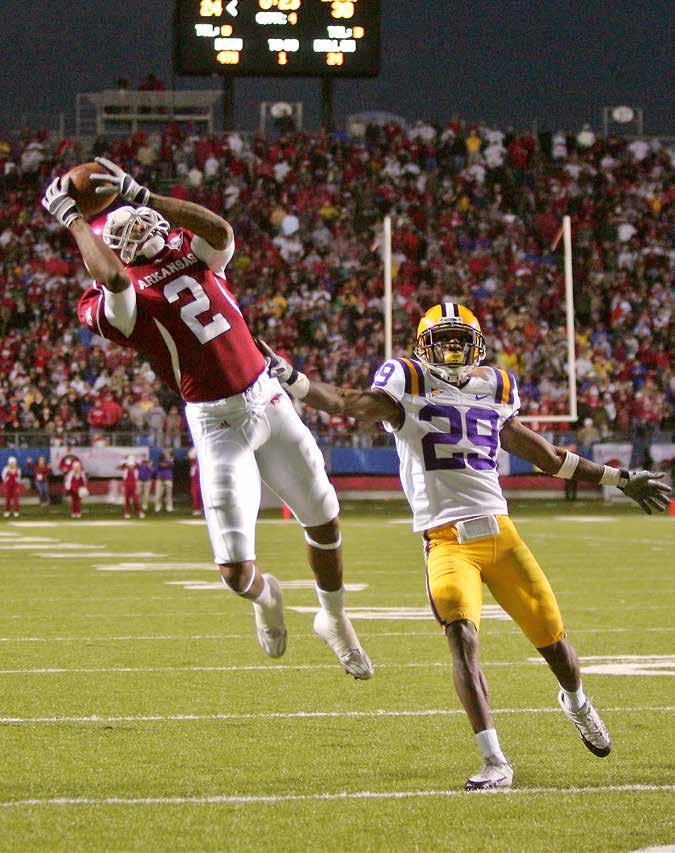
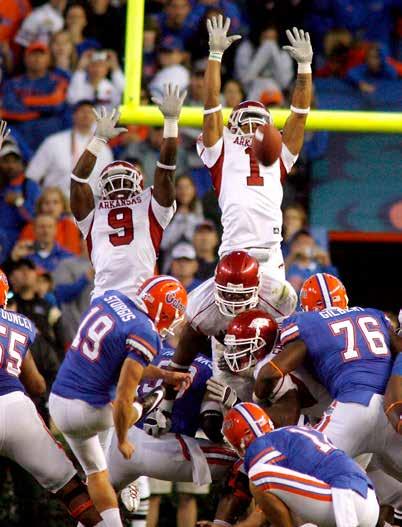
ABOVE: Florida’s Caleb Sturgis kicks a 27-yard field goal with 9 seconds remaining to give the No. 1 Gators a controversial 23-20 win in 2009. The officiating crew was suspended by the SEC the following week for questionable calls in the fourth quarter. COURTESY JASON IVESTER
LEFT: London Crawford’s 24-yard touchdown catch with 22 seconds remaining was dubbed the “Miracle on Markham II,” and Arkansas defeated LSU 31-30 in the final game of the 2008 season. COURTESY BENJAMIN KRAIN







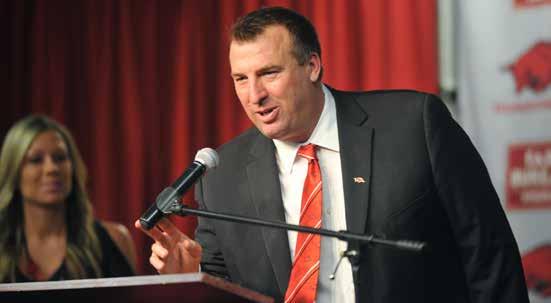
THE BIELEMA YEARS
IN DECEMBER 2012 , Bret Bielema shocked the college football world by leaving Wisconsin, where he had won three consecutive Big Ten championships, for Arkansas, which was coming off a 4-8 season and still reeling from Bobby Petrino’s firing eight months earlier.
Bielema, an easy-going, flip-flop-wearing coach who had the propensity to say whatever was on his mind, represented a sharp change from Petrino’s stern, buttoned-up approach. Bielema promised a ground-and-pound offensive style that had produced several 1,000-yard rushers at Wisconsin, another contrast to his predecessor, whose teams had rewritten the school record book throwing the ball. While the statistics were there, the transition to winning proved much more difficult. Bielema
became an unpopular coach to many after his inaugural season, when Arkansas lost nine straight games to end the year and finish winless in conference play for the first time in program history.
The Razorbacks improved the next two seasons, winning seven games in 2014 and eight games in 2015, each capped by a bowl win. Arkansas appeared on track for another improvement in the overall record after a 7-4 start to the 2016 season, but it blew leads of 17 and 24 points in the final two games against Missouri and Virginia Tech, ratcheting up fan discontent during a season that also included a 53-point loss to Auburn. Things did not go better for Bielema in 2017, which turned out to be his final season. A preseason injury ended the career of All-SEC running back
Rawleigh Williams and a lack of quality depth was exposed through in-season injuries to other starters. A lack of football success was cited when Arkansas athletics director Jeff Long was fired in mid-November, and the writing was on the wall for the coach he had hired and publicly backed as recently as two months earlier.
Counting the two losses to end the year before, Bielema finished his tenure with 10 losses in his final 14 games, and he was fired minutes after a season-ending loss to Missouri, 12 days after Long was fired.
Bielema’s five teams at Arkansas had a combined record of 29-34, including 11-29 in SEC games.
ABOVE: Bret Bielema speaks during his introductory press conference at Arkansas in December 2012. Bielema’s wife, Jen, watches in the background. COURTESY MICHAEL WOODS
RIGHT: Alex Collins’ 80-yard touchdown helped Arkansas put away Texas Tech in 2014. The 49-28 win was the Razorbacks’ first road win under Bret Bielema.
BELOW RIGHT: Darius Philon celebrates a safety during Arkansas’ 31-7 win over Texas in the 2014 Texas Bowl in Houston. The Razorbacks held the Longhorns to 59 yards of total offense. COURTESY
BELOW: Arkansas offensive lineman Dan Skipper leaves the field following a 35-28 overtime loss to Texas A&M in 2014. Skipper had two critical penalties in the game that aided the Aggies’ comeback from a 14-point deficit, including a tripping penalty early in the fourth quarter that erased a 55-yard run to the Texas A&M 3.
COURTESY RICK MCFARLAND

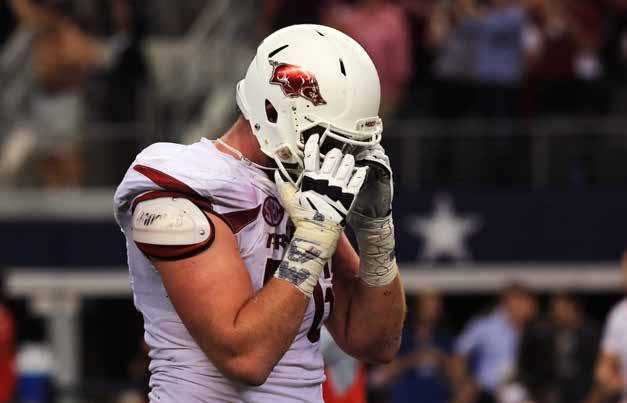

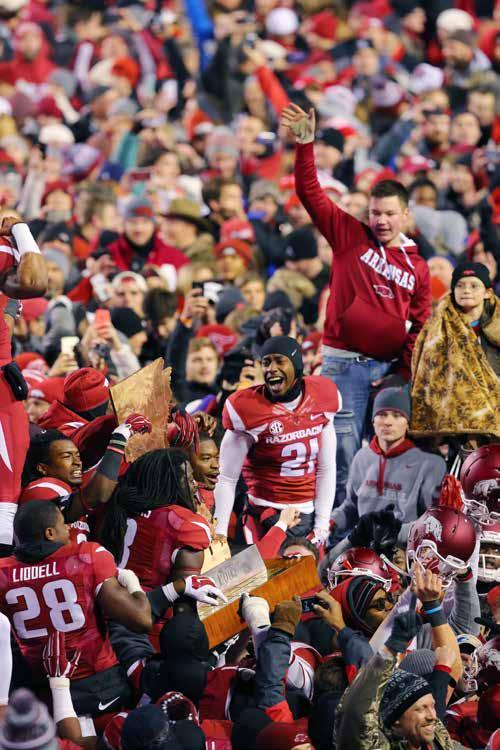
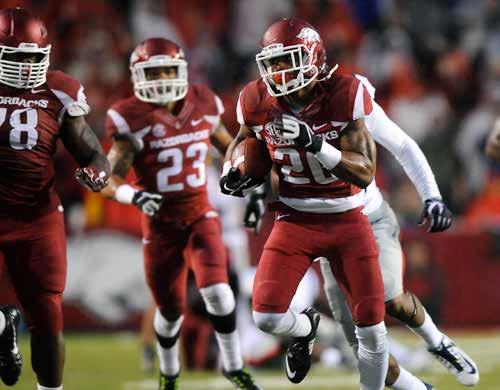
ABOVE: Rohan Gaines’ 100-yard interception return for a touchdown punctuated Arkansas’ 30-0 win over Ole Miss in the final home game of 2014. The Razorbacks became the first team in college football history to shutout consecutive top 25 opponents. COURTESY J.T. WAMPLER
LEFT: Arkansas players and fans celebrate with The Boot trophy following the Razorbacks’ 17-0 win over LSU in 2014. The win snapped a 17-game SEC losing streak for Arkansas. COURTESY STEPHEN B. THORNTON
